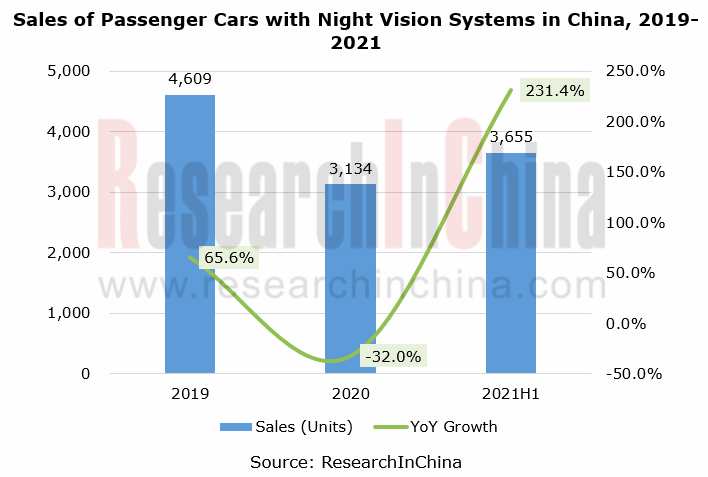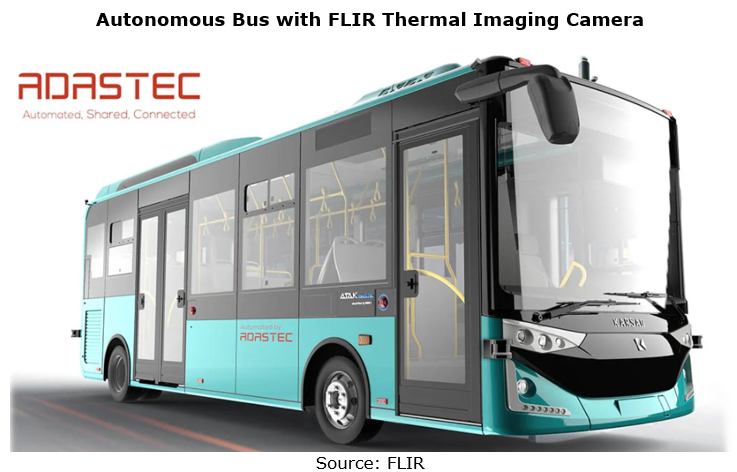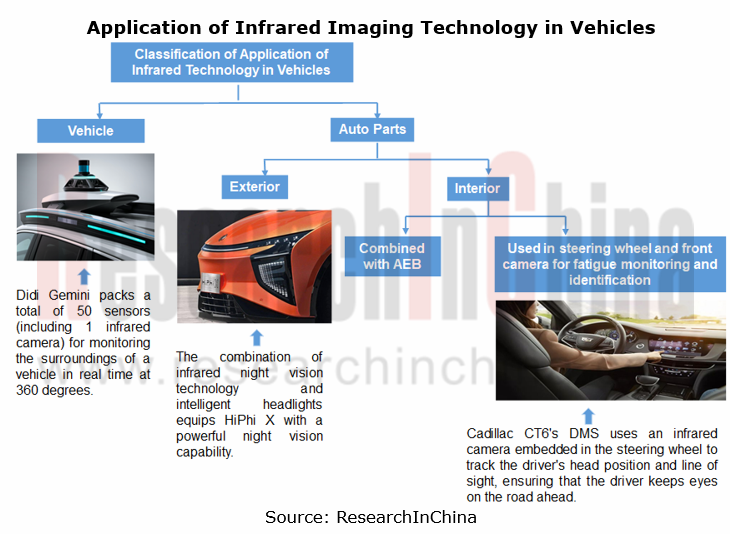Infrared night vision research: as 60% traffic accidents happen at night, infrared imaging technology comes as an effective solution.
This report combs through development trends and market size of automotive infrared night vision, technology routes of main Chinese and foreign night vision system suppliers, and night vision system application of OEMs.
The statistics show that China saw nearly 200,000 traffic accidents happen every year in recent years, 60% of which took place at night and caused 50% of death toll. It is more dangerous to drive at night for the factors such as insufficient lighting and low visibility make drivers miss out or misjudge road conditions. Infrared thermography which is free of visible light can recognize targets with vital signs accurately either in the daytime or at night. With its anti-glare merit, this technology has great potential to protect driving safety at night.
In 2021H1, the sales of passenger cars equipped with night vision systems surged.

From the sales of passenger cars packing night vision systems in China, it can be seen that despite an annualized plunge of 32.0% during the COVID-19 pandemic in 2020, the automobile industry has resumed production in China’s efforts to control the outbreak, selling 3,655 cars with night vision systems in the first half of 2021 alone, a like-on-like spurt of 231.4%. Wherein, Cadillac, Audi and Volkswagen models were the key contributors to the soaring sales of night vision systems in this period.
In current stage, night vision systems still tend to be mounted on high-class models. Through the lens of the sales of passenger cars packing night vision systems in recent two years, those priced above RMB300,000 swept over 85% of the sales, of which the higher than RMB500,000 cars occupied over 60% share. Meanwhile, cars with prices ranging from RMB250,000 to RMB300,000 carried night vision systems as well, sharing 10.3% of the sales in 2020.
The declining cost of infrared detectors and the improving policies make automotive infrared night vision a promising market.
In the past, high price was an enduring constraint on wide adoption of automotive infrared night vision systems. The technology advances have driven down the cost fast:
- The maturing wafer-level and 3D packaging helps to lower the cost of detectors, a key component of infrared night vision system.
- The homemade infrared sensors break the foreign monopoly, having a considerable cost advantage.
- Smaller pixel size drags down the cost of both infrared detector and system integration. Raytron Technology already develops the world’s first large area array uncooled infrared detector with pixel spacing of 8μm and area array size of 1920× 1080, meeting the needs of high-end products that require high resolution and light weight.

The National Technical Committee of Auto Standardization has released the Automotive Active Infrared Detection System (Draft for Comments) and the Automotive Passive Infrared Detection System (Draft for Comments). The deadline for comments is September 27, 2021. The European New Car Assessment Program (E-NCAP) again introduced a range of new tests in the E-NCAP 2018, including AEB cyclist test, pedestrian detection in dark and hazy lighting conditions, and vehicle under test (VUT) hid by obstacles. As the relevant laws and regulations are further improved, the automotive night vision system market has a rosy prospect.
Infrared imaging technology finds ever wider application in autonomous driving.

The application of infrared imaging technology in autonomous driving has become more widespread over the past years, for example:
- In December 2020, Zoox introduced its first autonomous battery electric vehicle equipped with the thermal imaging camera provided by Teledyne FLIR. This device can accurately recognize and classify objects in urban streets around the clock.
- In March 2021, Apple was granted a patent for the night vision system that combines visible light, near-infrared (NIR), and long-wave infrared (LWIR) sensors. The system is applicable to autonomous vehicles.
- On the first day of the Auto Shanghai 2021, Didi Autonomous Driving and Volvo jointly launched “DiDi Gemini”, a new-generation L4 autonomous test vehicle which packs a total of 50 sensors including 1 infrared camera.
- In May 2021, ADASTEC integrated two Teledyne FLIR thermal imagers into its flowride.ai automation platform, with the primary focus on improving detection and safety of all vulnerable road users on or near the road and at bus stops.

Safety is a frequent topic of autonomous driving. Also, autonomous driving needs to have the ability to perceive beyond visual range and work 24/7, in all weather conditions. Infrared imaging technology can meet its needs.
Infrared sensors are a complement to visible light cameras that fail to detect pedestrians in dark conditions. They are not only more affordable than LiDAR but a remedy for the natural defect of LiDAR that it cannot classify objects.
Moreover, infrared sensors can work all day long, which is required by autonomous driving, and provides a longer visual range (the average active vehicle infrared night vision system detects 150m to 200m, and the average passive vehicle infrared night vision system up to 300m). Infrared thermography thus becomes an indispensable technology in the autonomous driving night vision field. The technology will fuse and work with other sensors to make driving safer by playing their respective role. As its price goes down, it will expedite the application of autonomous driving technologies.
As Adasky, an infrared night vision device vendor, said, its Viper infrared thermal imager is not launched to replace a certain type of sensor but works with this sensor to fill the targeted gaps left by other solutions in autonomous driving, so that vehicles have a stronger ability to perceive the surroundings and make decisions.
China Automotive Lighting and Ambient Lighting System Research Report, 2025
Automotive Lighting System Research: In 2025H1, Autonomous Driving System (ADS) Marker Lamps Saw an 11-Fold Year-on-Year Growth and the Installation Rate of Automotive LED Lighting Approached 90...
Ecological Domain and Automotive Hardware Expansion Research Report, 2025
ResearchInChina has released the Ecological Domain and Automotive Hardware Expansion Research Report, 2025, which delves into the application of various automotive extended hardware, supplier ecologic...
Automotive Seating Innovation Technology Trend Research Report, 2025
Automotive Seating Research: With Popularization of Comfort Functions, How to Properly "Stack Functions" for Seating?
This report studies the status quo of seating technologies and functions in aspe...
Research Report on Chinese Suppliers’ Overseas Layout of Intelligent Driving, 2025
Research on Overseas Layout of Intelligent Driving: There Are Multiple Challenges in Overseas Layout, and Light-Asset Cooperation with Foreign Suppliers Emerges as the Optimal Solution at Present
20...
High-Voltage Power Supply in New Energy Vehicle (BMS, BDU, Relay, Integrated Battery Box) Research Report, 2025
The high-voltage power supply system is a core component of new energy vehicles. The battery pack serves as the central energy source, with the capacity of power battery affecting the vehicle's range,...
Automotive Radio Frequency System-on-Chip (RF SoC) and Module Research Report, 2025
Automotive RF SoC Research: The Pace of Introducing "Nerve Endings" such as UWB, NTN Satellite Communication, NearLink, and WIFI into Intelligent Vehicles Quickens
RF SoC (Radio Frequency Syst...
Automotive Power Management ICs and Signal Chain Chips Industry Research Report, 2025
Analog chips are used to process continuous analog signals from the natural world, such as light, sound, electricity/magnetism, position/speed/acceleration, and temperature. They are mainly composed o...
Global and China Electronic Rearview Mirror Industry Report, 2025
Based on the installation location, electronic rearview mirrors can be divided into electronic interior rearview mirrors (i.e., streaming media rearview mirrors) and electronic exterior rearview mirro...
Intelligent Cockpit Tier 1 Supplier Research Report, 2025 (Chinese Companies)
Intelligent Cockpit Tier1 Suppliers Research: Emerging AI Cockpit Products Fuel Layout of Full-Scenario Cockpit Ecosystem
This report mainly analyzes the current layout, innovative products, and deve...
Next-generation Central and Zonal Communication Network Topology and Chip Industry Research Report, 2025
The automotive E/E architecture is evolving towards a "central computing + zonal control" architecture, where the central computing platform is responsible for high-computing-power tasks, and zonal co...
Vehicle-road-cloud Integration and C-V2X Industry Research Report, 2025
Vehicle-side C-V2X Application Scenarios: Transition from R16 to R17, Providing a Communication Base for High-level Autonomous Driving, with the C-V2X On-board Explosion Period Approaching
In 2024, t...
Intelligent Cockpit Patent Analysis Report, 2025
Patent Trend: Three Major Directions of Intelligent Cockpits in 2025
This report explores the development trends of cutting-edge intelligent cockpits from the perspective of patents. The research sco...
Smart Car Information Security (Cybersecurity and Data Security) Research Report, 2025
Research on Automotive Information Security: AI Fusion Intelligent Protection and Ecological Collaboration Ensure Cybersecurity and Data Security
At present, what are the security risks faced by inte...
New Energy Vehicle 800-1000V High-Voltage Architecture and Supply Chain Research Report, 2025
Research on 800-1000V Architecture: to be installed in over 7 million vehicles in 2030, marking the arrival of the era of full-domain high voltage and megawatt supercharging.
In 2025, the 800-1000V h...
Foreign Tier 1 ADAS Suppliers Industry Research Report 2025
Research on Overseas Tier 1 ADAS Suppliers: Three Paths for Foreign Enterprises to Transfer to NOA
Foreign Tier 1 ADAS suppliers are obviously lagging behind in the field of NOA.
In 2024, Aptiv (2.6...
VLA Large Model Applications in Automotive and Robotics Research Report, 2025
ResearchInChina releases "VLA Large Model Applications in Automotive and Robotics Research Report, 2025": The report summarizes and analyzes the technical origin, development stages, application cases...
OEMs’ Next-generation In-vehicle Infotainment (IVI) System Trends Report, 2025
ResearchInChina releases the "OEMs’ Next-generation In-vehicle Infotainment (IVI) System Trends Report, 2025", which sorts out iterative development context of mainstream automakers in terms of infota...
Autonomous Driving SoC Research Report, 2025
High-level intelligent driving penetration continues to increase, with large-scale upgrading of intelligent driving SoC in 2025
In 2024, the total sales volume of domestic passenger cars in China was...